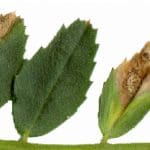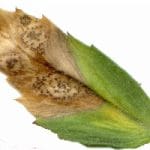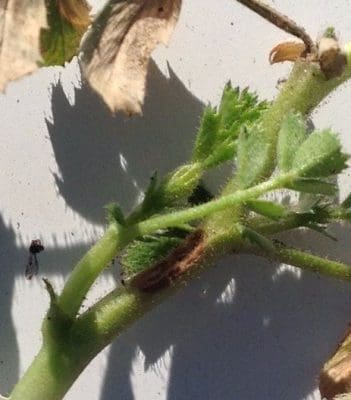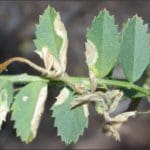THE devastating chickpea disease, Ascochyta blight, has made an early appearance this season with agronomists detecting the first outbreaks of the disease in emerging crops in southern Queensland.
Pulse Australia northern industry development manager, Paul McIntosh, said after a big year for chickpeas last year that left high inoculum levels throughout the cropping areas, concerns the disease would flare again this year were being realised.
“Ascochyta sightings have been confirmed in south Queensland. It is on crops that are only two inches high. It is in Seamer, the new variety, but all varieties can easily get it,” he said.
“It is very early and there is a long way to go. It is no time to be blasé. With the amount of infections that were around last year across all varieties, we need to be super careful this year, and that includes looking after Seamer.”
Mr McIntosh said the detection of Ascochyta in crops so early in the season was a warning to everyone growing chickpeas in or near any chickpea crops from last year or the year before to be extra vigilant and plan their control strategies.
“Before any rainfall events farmers need to consider their spraying options with fungicides because all the fungicides are basically prevention, so you need to have the fungicide applied just before rain,” he said.
Mr McIntosh said he was expecting another big planting of chickpeas this season with a substantial area already sown and plenty of time for more to go in.
“I would say 60 to 70 per cent of the national crop is in, but there is still a lot more to go,” he said.
NSW Department of Primary Industries (DPI) plant pathologist Dr Kevin Moore said the higher incidence of Ascochyta blight in chickpea crops in 2016, and the discovery already of Ascochyta this season in Queensland, was a reminder to growers to be vigilant.
“The diagnosis by a local agronomist (of Ascochyta in a Qld crop) was based on symptoms and the presence of pycnidia in leaf and stem lesions with samples being sent to NSW DPI for confirmation,” Dr Moore said.
“The crop was planted in the last week of April and received 15mm of rain in mid-May. However the crop was not sprayed with a fungicide before the rain.
“The outbreak may have involved seed borne Ascochyta, but the multiple lesions on infected plants indicate a high level of Ascochyta inoculum was in the paddock at planting as infected chickpea residue from the 2016 crop (i.e. chickpea on chickpea).
“This case highlights one of the risks of planting chickpea back into its own residue. Other risks are Sclerotinia and Phytophthora, which unlike Ascochyta, cannot be controlled in-crop. As Sclerotinia and Phytophthora are soil borne diseases, once they have established in a paddock they pose on-going threats.
“It is recommended that all varieties, including PBA Seamer and PBA HatTrick should be sprayed with a registered Ascochyta fungicide prior to the first rain event after crop emergence, three weeks after emergence, or at the three-branch stage of crop development, whichever occurs first.”
Dr Moore said the best practice recommendations for disease control in chickpea crops were to maintain a 1-in-4 year rotation; avoid planting next to last year’s chickpea stubble if possible; ensure all planting seed was pickled and follow the recommended in-crop ascochyta fungicide strategy for the sown variety.
“The successful disease management in chickpeas relies heavily on an integrated management package involving crop sequencing, variety choice, seed treatment, strategic fungicide use and hygiene.
“Growers are advised that back to back chickpea production can also impact on the chickpea industry through the risk of changes in the pathogen, reduced commercial life of varieties and the resistance to fungicides.”
……………………………………………………………………………………
What to look for:
Aschoyta blight infects the leaves, stems and pods of chickpea plants, causing tan/brown, rounded lesions on affected plant parts.

Lesions usually begin as a pale green-yellow discolouration on leaves and stems and progress into small round lesions with dark-brown margins and pale grey to tan sunken centres.
Symptoms become visible in 4–5 days as a pale green/yellow discolouration on leaves, often referred to as ‘ghosting’.
Toward the centre of the lesion, small, black fruiting bodies called pycnidia develop in 7–10 days, often in concentric rings.
Spores ooze out of pycnidia and are spread by rain-splash upwards within the plant and sideways to nearby healthy plants.
Lesions often girdle the stems of the plant, causing them to weaken and subsequently break off, making later detection difficult.
Circular ‘hot spots’ or ‘foci’ consisting of plants with severe infection can appear in crops but by this stage considerable damage has occurred. Seeds can become infected after lesions develop on pods.

Note the concentric circles of brown–black dots in the centre of the lesions. These pycnidia or fruiting bodies are unique to Ascochyta blight.
Initial symptoms are commonly the wilting of individual or small groups of seedlings.
Patches of wilted, pruned, and dying plants develop within the crop; these patches appear as premature haying off.
Circular spots with tan to grey centres with dark brown to black margins develop on leaves, stems and pods.
………………………
Source: Pulse Australia, http://www.pulseaus.com.au/growing-pulses/bmp/chickpea/ascochyta-blight
……………………..
See also:
GRDC video ‘Pointing the lens at Ascochyta blight’: https://www.youtube.com/watch?v=Hq-nzwdbHds&feature=youtu.be
Information on chickpea disease management can be found in the NSW DPI publication Winter crop variety sowing guide available on the DPI website
www.dpi.nsw.gov.au/agriculture/broadacre-crops/guides/publications/winter-crop-variety-sowing-guide







HAVE YOUR SAY